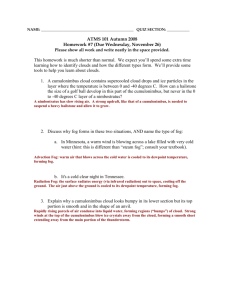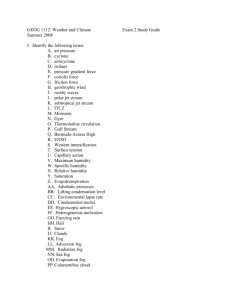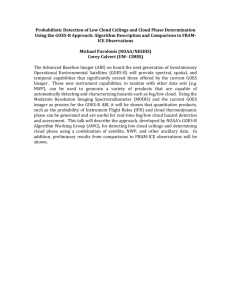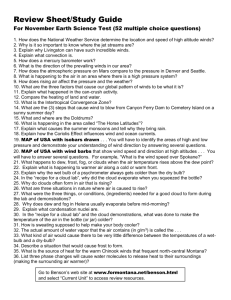B. Smart Traffic Lights and Connected Vehicles
advertisement
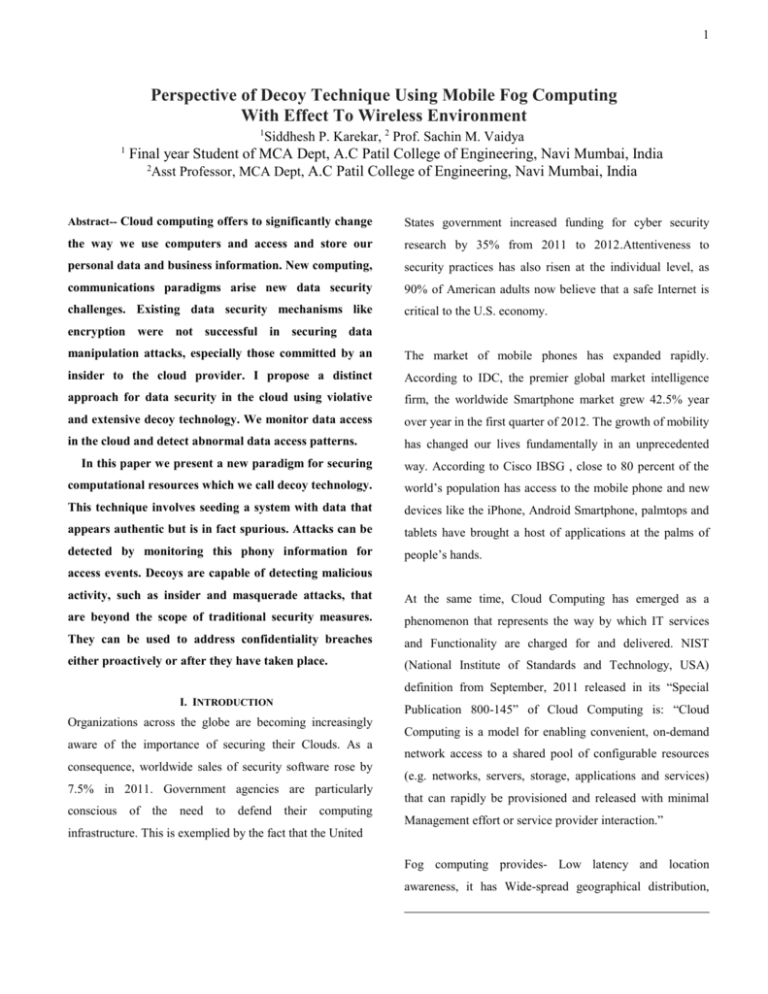
1 Perspective of Decoy Technique Using Mobile Fog Computing With Effect To Wireless Environment 1 1 Siddhesh P. Karekar, 2 Prof. Sachin M. Vaidya Final year Student of MCA Dept, A.C Patil College of Engineering, Navi Mumbai, India 2 Asst Professor, MCA Dept, A.C Patil College of Engineering, Navi Mumbai, India Abstract-- Cloud computing offers to significantly change States government increased funding for cyber security the way we use computers and access and store our research by 35% from 2011 to 2012.Attentiveness to personal data and business information. New computing, security practices has also risen at the individual level, as communications paradigms arise new data security 90% of American adults now believe that a safe Internet is challenges. Existing data security mechanisms like critical to the U.S. economy. encryption were not successful in securing data manipulation attacks, especially those committed by an The market of mobile phones has expanded rapidly. insider to the cloud provider. I propose a distinct According to IDC, the premier global market intelligence approach for data security in the cloud using violative firm, the worldwide Smartphone market grew 42.5% year and extensive decoy technology. We monitor data access over year in the first quarter of 2012. The growth of mobility in the cloud and detect abnormal data access patterns. has changed our lives fundamentally in an unprecedented In this paper we present a new paradigm for securing way. According to Cisco IBSG , close to 80 percent of the computational resources which we call decoy technology. world’s population has access to the mobile phone and new This technique involves seeding a system with data that devices like the iPhone, Android Smartphone, palmtops and appears authentic but is in fact spurious. Attacks can be tablets have brought a host of applications at the palms of detected by monitoring this phony information for people’s hands. access events. Decoys are capable of detecting malicious activity, such as insider and masquerade attacks, that At the same time, Cloud Computing has emerged as a are beyond the scope of traditional security measures. phenomenon that represents the way by which IT services They can be used to address confidentiality breaches and Functionality are charged for and delivered. NIST either proactively or after they have taken place. (National Institute of Standards and Technology, USA) definition from September, 2011 released in its “Special I. INTRODUCTION Organizations across the globe are becoming increasingly aware of the importance of securing their Clouds. As a consequence, worldwide sales of security software rose by 7.5% in 2011. Government agencies are particularly conscious of the need to defend their computing Publication 800-145” of Cloud Computing is: “Cloud Computing is a model for enabling convenient, on-demand network access to a shared pool of configurable resources (e.g. networks, servers, storage, applications and services) that can rapidly be provisioned and released with minimal Management effort or service provider interaction.” infrastructure. This is exemplied by the fact that the United Fog computing provides- Low latency and location awareness, it has Wide-spread geographical distribution, 2 supports Mobility, is compromised due to the huge number computing (MCC) is introduced as an integration of cloud of nodes. The main task of fog is to deliver data and place it computing into the mobile environment. Mobile cloud closer to the user who is positioned at a location which at the computing brings new types of services and facilities for edge of the network. Here the term edge refers to different mobile users to take full advantages of cloud computing. nodes to which the end user is connected and it is also called edge computing. If we look according to architecture fog is II. FOG COMPUTING situated below the cloud at the ground level. The term fog In Fog computing, services can be hosted at end devices computing is given by CISCO as a new technology in which such as set-top-boxes or access points. The infrastructure of mobile devices interact with one another and support the this new distributed computing allows applications to run as data communication. close as possible to sensed actionable and massive data, coming out of people, processes and thing. Such Fog Mobile devices (e.g., Smartphone, tablet pcs, etc) are computing concept, actually a Cloud computing close to the increasingly becoming an essential part of human life as the ‘ground’, creates automated response that drives the value. most effective and convenient communication tools not In the past few years, Cloud computing has provided many bounded by time and place. Mobile users accumulate rich opportunities for enterprises by offering their customers a experience of various services from mobile applications range of computing services. Current “pay-as-you-go” Cloud (e.g., iPhone apps, Google apps, etc), which run on the computing model becomes an efficient alternative to owning devices and/or on remote servers via wireless networks. The and managing private data centers for customers facing Web rapid progress of mobile computing (MC) becomes a applications and batch processing . Cloud computing frees powerful trend in the development of IT technology as well the enterprises and their end users from the specification of as commerce and industry fields. However, the mobile many details, such as storage resources, computation devices are facing many challenges in their resources (e.g., limitation and network communication cost. battery life, storage, and bandwidth) and communications (e.g., mobility and security). The limited resources However, this bliss becomes a problem for latency-sensitive significantly impede the improvement of service qualities. applications, which require nodes in the vicinity to meet Cloud computing (CC) has been widely recognized as the their delay requirements. When techniques and devices of next generation’s computing infrastructure. CC offers some IoT are getting more involved in people’s life, current Cloud advantages by allowing users to use infrastructure (e.g., computing paradigm can hardly satisfy their requirements of servers, networks, and storages), platforms (e.g., middleware mobility support, location awareness and low latency. Fog services and operating systems), and softwares (e.g., computing is proposed to address the above problem . As application programs) provided by cloud providers (e.g., Fog computing is implemented at the edge of the network, it Google, Amazon, and Sales force) at low cost. In addition, provides low latency, location awareness, and improves CC enables users to elastically utilize resources in an on- quality-of-services (QoS) for streaming and real time demand fashion. As a result, mobile applications can be applications. rapidly provisioned and released with the minimal automation, transportation, and networks of sensors and management efforts or service provider’s interactions. actuators. Moreover, this new infrastructure supports Typical examples include industrial heterogeneity as Fog devices include end-user devices, With the explosion of mobile applications and the support of access points, edge routers and switches. The Fog paradigm CC for a variety of services for mobile users, mobile cloud is well positioned for real time big data analytics, supports 3 densely distributed data collection points, and provides profiling can be done. As there is a huge amount of advantages information available on the web or Internet therefore from in entertainment, advertising, personal computing and other applications. last few years personal information agents are helping the users to manage their information. They said earlier only Fog Computing is an extension of Cloud Computing. As in a supervised learning technique was used in general. But for Cloud, Fog computing also provides data, compute, storage, moving the information agents to the next level authors are and application services to end-users. The difference is Fog focusing on assessment of semantically useful user profiles. provides proximity to its end users through dense They said that account hijacking is a disadvantage for such geographical distribution and it also supports mobility. user profiling. Sabahi, F. mentioned threats and response of Access points or set-up boxes are used as end devices to cloud computing. He presented a comparison of the benefits host services at the network. These end devices are also and risks of compromised security and privacy. He termed as edge network. Fog computing improves the discussed about the most common attacks nowadays are Quality of service and also reduces latency. According to Distributed Denial of Service attacks. The solution to these Cisco, due to its wide geographical distribution the Fog attacks can be, cloud technology offering the benefit of computing is well suited for real time analytics and big data. flexibility, with the ability to provide resources almost While Fog nodes provide localization, therefore enabling instantaneously as necessary to avoid site shutdown. low latency and context awareness, the Cloud provides Considering all these requirements, this prototype is created global centralization. Madsen.H and Albeanu. G presented which includes two main steps: first is to create users and the challenges faced by current computing paradigms and generate patterns of their different access behaviors, next discussed how Fog computing platforms are feasible with step is monitoring the user access patterns which is done cloud and are reliable for real life projects. Fog computing is using CUSUM that is cumulative summation algorithm to mainly done for the need of the geographical distribution of find the accuracy of the procedure. resources instead of having a centralized one. A multi-tier architecture is followed in Fog computing platforms. In first tire there is machine to machine communication and the higher tiers deal with visualization and reporting. The higher tier is represented by the Cloud. They said that building Fog computing projects are challenging .But there are algorithms and methodologies available that deal with reliability and ensure fault tolerance. With their help such real life projects are possible. Z. Jiang et al. Discussed Fog computing architecture and further used it for improving Web site's performance with the help of edge servers. They said that the emerging architecture of Fog Computing is highly virtualized. They presented that their idea that the Fog servers monitor the requests made by the users and keep a record of each request by using the user’s IP address or MAC address. Godoy et al. explained that there is a need of such profiling strategies or methods through which user Applications of Fog Computing A. Smart Grid Energy load balancing applications may run on network edge devices, such as smart meters and micro-grids. Based on energy demand, availability and the lowest price, these devices automatically switch to alternative energies like solar and wind. Fog collectors at the edge process the data generated by grid sensors and devices, and issue control commands to the actuators. They also filter the data to be consumed locally, and send the rest to the higher tiers for visualization, realtime reports and transactional analytics. Fog supports ephemeral storage at the lowest tier to semi-permanent storage at the highest tier. Global 4 coverage is provided by the Cloud with business intelligence analytics. B. Smart Traffic Lights and Connected Vehicles Video camera that senses an ambulance flashing lights can automatically change street lights to open lanes for the vehicle to pass through traffic. Smart street lights interact locally with sensors and detect presence of pedestrian and bikers, and measure the distance and speed of approaching vehicles. Intelligent lighting turns on once a sensor identifies movement and switches off as traffic passes. Neighboring smart lights serving as Fog devices coordinate to create green traffic wave and send warning signals to approaching vehicles. Wireless access points like WiFi, 3G, road-side units and smart traffic lights are deployed along the roads. Vehicles to Vehicle, vehicle to access points, and access points to access points interactions enrich the application of this scenario. D. Decentralized Smart Building Control The applications of this scenario are facilitated by wireless sensors deployed to measure temperature, humidity, or levels of various gases in the building atmosphere. In this case, information can be exchanged among all sensors in a floor, and their readings can be combined to form reliable measurements. Sensors will use distributed decision making and activation at Fog devices to react to data. The system components may then work together to lower the temperature inject fresh air or open windows. Air conditioners can remove moisture from the air or increase the humidity. Sensors can also trace and react to movements (e.g, by turning light on or off). Fog devices could be assigned at each floor and could collaborate on higher level of actuation. With Fog computing applied in this scenario, smart buildings can maintain their fabric, external and internal environments to conserve energy, water and other C. Wireless Sensor and Actuator Networks resources. Traditional wireless sensor networks fall short in applications that go beyond sensing and tracking, but III. DECOY TECHNIQUE require actuators to exert physical actions like opening, Decoys are typically thought of as larger- scale, lower closing or even carrying sensors . fidelity systems intended to change the statistical success In this scenario, actuators serving as Fog devices can rate of tactical attacks. The basic idea is to fill the search control the measurement process itself, the stability and space of the attacker’s intelligence effort with decoys so that the oscillatory behaviours by creating a closed-loop detection and differentiation of real targets becomes difficult system. or expensive. In this approach, the attacker seeking to find a For example, in the scenario of self-maintaining trains, target does a typical sweep of an address space looking for sensor monitoring on a train’s ball-bearing can detect some set of services of interest. DWALL and Responder are heat levels, allowing applications to send an automatic also useful for high fidelity deceptions, but these deceptions alert to the train operator to stop the train at next require far more effort. Tools like “Nmap” map networks station for emergency maintenance and avoid potential and provide lists of available services, while more derailment. sophisticated vulnerability testing tools identify operating In lifesaving air vents scenario, sensors on vents system and server types and versions and associate them monitor air conditions flowing in and out of mines and with specific vulnerabilities. Penetration testing tools go a automatically change air-flow if conditions become step further and provide live exploits that allow the user to dangerous to miners. semi- automatically exploit identified vulnerabilities and do 5 multistep attack sequences with automated assistance. These attack tools despite their limitations. As long as the chaff tools have specific algorithmic methods of identifying costs less than the risks it mitigates, it is a good defense, and known the as long as simple deceptions reduce risk by more than the characteristics of the tools are readily identified by targets of cost to deploy and operate them, they are good defenses as their attacks if properly designed for that purpose. well. Higher quality decoys are also worthwhile, but as the systems types and vulnerabilities, and quality of the decoy goes up, so does its cost. While some of The defender can then simulate a variety of operating the more complex decoy systems like DWALL provide systems and services using these tools so that the user of the more in- depth automation for larger scale deceptions, the attack tools makes cognitive errors indirectly induced by the cost of these systems is far greater than Deception ToolKit exploitation of cognitive errors in their tools. The deceived as well. Lower fidelity systems like IR or Responder cost attacker than proceeds down defender- desired attack graphs under $10,000 and cover the same sized address space. while the defender traces the attacks to their source, calls in While Responder and IR can be used to implement the law enforcement or other response organizations, or feeds DWALL functions, they also require additional hardware false information to the attacker to gain some strategic and programming to achieve the same level of fidelity. At advantage. In at least one case, defenders included Trojan some point the benefits of higher fidelity decoys are horse components in software placed in a honeypot with the outweighed by their costs intent of having that software stolen and used by the . attackers. The Trojan horse contained mechanisms that Properties of Decoy induced covert channels in communication designed to give It is easy to see that some decoy material is more applicable the so called defenders an attack capability against the (so- to certain scenarios than others. Similarly, certain genres of called) attackers’ systems. Of course not all decoys are so decoys may be more applicable to specific corporate high quality. Simple decoys like Deception ToolKit are environments. In order to design decoys that are as effective simple to detect and defeat. Yet after more than seven years as possible, it is also beneficial to analyze them in a more of use, they are still effective at detecting and defeating low general sense by considering characteristics that are quality attackers that dominate the attack space. Such tools independent of a particular context. As initially explored by are completely automatic and inexpensive to operate, don’t Bowen et. al in , several abstract properties exist that define interfere with normal use, and provide clear detailed how a decoy should operate under ideal circumstances. indications of the presence of attacks in a timely fashion. Some of these attributes concern the relationship between While they are ineffective against high skills attackers, they adversaries and decoy data, while others pertain to the do free up time and effort that would otherwise be spent on interactions between legitimate users and deceptive material. less skilled attackers. This is similar to the effectiveness of decoys in military systems. Just as typical chaff defeats A perfectly believable decoy "would precisely conform to many automated heat or radar seeking attack missiles, all of these guidelines, though practical restrictions prevent simple informational deceptions defeat automated attack this from occurring in most situations. Although there exists tools. And just as good pilots are able to see past deceptions some overlap between these traits, it is also worth noting like chaff, so skilled information attackers are able to defeat that they are not completely orthogonal. For example, see past deceptions like Deception ToolKit. And just as believability and differentiability are in contention to some chaff is still used in defeating missiles despite its limitations, extent. so should simple deceptions be used to defeat automated 6 the real documents that are in the adversary's pool of A. Believability One of a decoy's primary functions is to be believable. Upon inspection, a decoy should appear authentic and trustworthy. In the absence of any additional information, it should be impossible to discern a spurious decoy from authentic data. C. Conspicuousness Conspicuousness is closely related to enticingness, as both influence the odds of an attacker accessing a document. Enticingness models how curious an Believability can be formalized via the following thought experiment. Consider a pool of files, some of which contain real data and some of which are fabricated decoys. Select a decoy file and real piece of data from this pool, and present it to an adversary. The selected decoy can be considered perfectly believable if this attacker has an equal probability of selecting the decoy and the legitimate document. This characteristic is of critical importance to externally observable features of decoys. adversary is about a decoy, while conspicuousness concerns how easy a decoy is to access. A conspicuous document is one that is easy to find and access. Conspicuousness can be thought of as the amount of effort an adversary must put in to discovering a decoy, or more formally, the number of actions that are required to access it. This characteristic captures the fact that decoy documents should be placed in obvious locations such as a user's desktop. It also demonstrates that it is In comparison, the believability of document content is of a lower priority. This is because an attacker would have already triggered an alert when opening the document by the time this information came in to play. helpful to place documents in high traffic file system locations, including working folders where files that are accessed on a day-to-day basis are stored. File system searches are also user actions that may result in the presence of decoys. Conspicuous decoys B. Enticingness This property takes our idealized decoy material one step further. Decoys should not only appear valid, but also attract an adversary's attention. adversary's objectives. Some malicious actors will be motivated by financial gain, and thus would be in documents containing should therefore be easily located by search queries. D. Detectability The aforementioned decoy properties all concern the This, of course, will be heavily influenced by an interested interest. monetary information. relationship between decoy documents and a potential attacker. Detectability, on the other hand, describes the ability of decoys to notify their owner when they have been accessed. An ideal decoy system would issue an alert each and every time a decoy is accessed, but A document's level of enticingness can be thought of as technical challenges, including network availability the probability that an adversary would be interested in and variability between software platforms, mean that its exfiltration. this may not always be possible in practice. A collection of interesting documents is the subset of Monitoring software can be placed in the operating documents for which this probability is above a certain system to detect predetermined tokens placed within threshold. In these terms, it is desirable that the decoys when they are opened. Further, operating probability of accessing any fake document which a system auditing can be enabled to record decoy decoy distribution system generates is at least equal to interactions. 7 It is particularly critical that decoy access events are must be taken lest the alarms that accomplish this arouse suspicion. detectable while an attack is taking place. Continuing to monitor this information allows for confidentially An overt mechanism for issuing alert beacons would violations to be handled after adversarial action has provide adversaries with an obvious signal thatan been carried out. element contains a trap, which completely violates the Decoy material usage should thus continue to raise property of decoy variability. The messages that are alerts after such data has been exfiltrated. Although it transmitted by decoys must therefore be as subtle and may be possible to evade detection in a particular covert as possible. practical decoy deployment, utilizing an extensive Raising an alert that decoy content has been accessed monitoring network will at the very least increase the necessarily involves taking some action, however. time and effort that is required to execute an attack. Even if precautions are taken, there is always the This will make exfiltration more difficult and slow possibility that this act will be perceptible to a down or discourage adversaries as a net effect. malicious actor. It is therefore also desirable to trigger beacon events as early as possible to prevent their E. Variability interception. Although a decoy distribution system should strive to make its fake documents seem as authentic as possible, it would certainly be undesirable if precisely the same well-crafted decoy file were placed repeatedly throughout a given system or network. This would G. Non-interference This property is the first to describe how decoys should coexist with legitimate users who are not masquerading with assumed credentials. greatly simplify the task of distinguishing between An optimal masquerader detection network would not legitimate data and the planted decoys that serveas affect the habits of typical users in any way. By monitors. inserting decoy material into an operating environment, In general, there should be as much variability between however, we introduce the possibility that this data will decoy documents as there exists in the pool of confuse users or otherwise hinder their ability to documents that they are intended to detect. That is, the complete their everyday tasks. task of identifying a decoy should not be reducible to If a file system is populated with decoy documents that identifying a particular invariant that exists between all serve as intrusion sensors, for example, the probability generated decoys. that the file system's primary owner is able to access a A different way to conceptualize variability is to consider the task of an adversary who wishes to extract particular standard document should remain the same as it was prior to the introduction of the decoy content. information from a system while remaining undetected. Introducing decoy applications to a mobile device's Variability among decoys essentially means that decoys operating system should not impact a user's ability to should remain believable even after the presence of access real applications as they normally would. other decoys has been revealed. F. Stealth While it is clearly desirable that every decoy access event be perceptible to the owners of a system, care H. Differentiability A decoy can be considered fully differentiable if a real user will always succeed at this task. Balancing the differentiability for authentic users against believability 8 for adversaries is one of the most critical aspects of any localization, and Cloud globalization, particularly for practical decoy deployment system. analytics and Big Data. Here we consider Smart Grid, which Though this may seem quite challenging, in practice, data hierarchies help illustrate further this interplay. Fog there are many properties that may be utilized to assist collectors at the edge ingest the data generated by grid decoy designers in this regard. Legitimate users should sensors and devices. Some of this data relates to protection be very familiar with detailed aspects of their data. and control loops that require real-time processing (from They will also utilize their system in fairly predictable milliseconds to sub seconds). ways. Masqueraders, on the other hand, will have a limited knowledge of the files they are trying to This first tier of the Fog, designed for machine-to-machine exfiltrate. (M2M) interaction, collects, process the data, and issues This gap in knowledge can be leveraged to increase control commands to the actuators. It also filters the data to decoy differentiability without affecting believability in be consumed locally, and sends the rest to the higher tiers. the process. The second and third tier deal with visualization and reporting (human-to machine [HMI] interactions), as well as I. Shelf Life The data that is relevant to a normal user's tasks gradually changes as new events occur. The timeliness of data is perhaps even more relevant to attackers, who frequently wish to abscond with the most recent data that they can possibly access. The freshness of material that a decoy contains therefore plays a large part in determining how it will be perceived and how closely it will react the aforementioned desirable characteristics. This creates a very appealing target by leading adversaries to believe that the decoy content has been added even more recently than the authentic data that a system contains. Of course, as time moves on and data is updated while new files are created, these decoys systems and processes (M2M). The time scales of these interactions, all part of the Fog, range from seconds to minutes (real-time analytics), and even days (transactional analytics). As a result of this the Fog must support several types of storage, from ephemeral at the lowest tier to semipermanent at the highest tier. We also note that the higher the tier, the wider the geographical coverage, and the longer the time scale. The ultimate, global coverage is provided by the Cloud, which is used as repository for data that that has a permanence of months and years, and which is the bases for business intelligence analytics. This is the typical HMI environment of reports and dashboards the display key performance indicators. will lose effectiveness. This can be seen as a shelf life during which decoys V. MOBILE CLOUD V/S FOG maintain an optimal level of functionality and after The which their efficiency begins to diminish. including distributed interactive games, video on demand emerging high quality multimedia applications and streaming demand large data transfer rates with low IV. ANALYSIS AND PLAY BETWEEN FOG AND delay, delay jitter and packet loss . In order to achieve this, CLOUD it is necessary to process these applications closer to the end While Fog nodes provide localization, therefore enabling users. Since cloud data centers are generally located within low latency and context awareness, the Cloud provides the Internet, it is difficult to manage these factors. Hence fog global centralization. Many applications require both Fog 9 computing is the practical solution for this kind of Data security and integrity are two most important performance sensitive applications. characteristics demanded by many Internet applications . Longer the data stays en-route, more vulnerable it is for Wireless sensor networks have been widely deployed in attacks even when encrypted. Hence it is always desirable to many environment related applications . These networks are have few hops between clients and servers. Fog computing generally characterized by low power, low bandwidth and provides the shortest possible distance while providing all limited processing capability nodes distributed across wide the other advantages of cloud computing. Hence fog geographical areas. These networks must be supported by computing is preferred over traditional cloud computing in low latency, location aware and widely distributed systems such situations. for processing and distributing the data. These are typical characteristics of fog computing rather than cloud computing. Even the availability of cloud systems located within the Internet can be attacked by miscreants using various Denial of Service (DoS) attack methods. The DoS attacks need not In this section, we take an in depth look at the similarities be carried out directly on the end systems themselves, even and dissimilarities of these two technologies with respect to attacks targeted towards the intermediary devices such as the demands of the emerging trends in networking. Table 1 routers can also be equally fatal. Hence there are many summarizes the results of the comparison. opportunities for hackers to target cloud computing systems. Table 1. Mobile Cloud Computing v/s Fog Computing Mobile Cloud Computing v/s Fog Computing Parameters Mobile Cloud Fog Computing Computing Latency High Low Delay Jitter High Very low Location of Within the Internet At the edge server nodes of the local network Distance Multiple hops One hop between the client and server Security Undefined Can be defined Attack on data High probability Very low enroute probability Location Yes Yes awareness Geographical Centralized Distributed distribution No. of server Few Very large nodes Support for Limited Supported Mobility Real time Supported Supported interactions Type of last mile Leased Wireless connectivity line,Wireless On the other hand fog computing nodes are highly distributed near the edge of the user networks, in order to attack the availability of these systems, it is necessary to carry out a massive attack on all the systems that are nearby a client. This needs massive resources from the attackers side too. Also there are not many intermediate devices that can be targeted by the attacker as for computing nodes are located very close to the end users. Hence it can be safely state that fog computing system is less prone to DoS attacks than cloud computing systems. From the above discussion, it can be seen that fog computing is more responsive to user needs and emerging new computing and networking paradigms than traditional cloud computing systems. Also fog computing is more resilient, rugged and secure than cloud computing in the face of changing needs and emerging trends. On the other hand, it must also be noted that cloud computing is not without its advantages. Since fog computing requires massive geographically distributed 10 implementation, the single nodes cannot have large amounts This is a capability that alternative security measures are not of resources due to financial reasons. However high end capable of offering. Although the deceptive techniques that business computing such as batch processing jobs, would form the basis of decoys have existed for ages, they have require large amounts of resources while not being very only recently been leveraged to protect computing resources. delay sensitive. These kinds of jobs can be handled using traditional cloud computing systems successfully more than This paper discussed several dimensions along which this fog nodes. process can be refined and extended. It included at tributes that all high quality decoys should share as well as contexts Hence fog computing will never be able to replace cloud in which decoys are particularly applicable. computing and become the sole cloud computing model of the future. Thus, it is safe to state that cloud and fog would Decoys can be integrated as useful components of any full exist side by side serving two different communities and featured security solution and will only increase in complement each other where necessary. prominence as threats against computer systems continue to grow. VI. CONCLUSION Mobile cloud computing is one of mobile technology trends We have outlined the vision and defined key characteristics in the future since it combines the advantages of both mobile of Fog Computing, a platform to deliver a rich portfolio of computing and cloud computing, thereby providing optimal new services and applications at the edge of the network. services for mobile users. According to a recent study by The the ABI Research, a New York-based firm, more than 240 discussion range from conceptual visions to existing point million businesses will use cloud services through mobile solution prototypes. We envision the Fog to be a unifying devices by 2015. That traction will push the revenue of platform, rich enough to deliver this new breed of emerging mobile cloud computing to $5.2 billion. motivating examples peppered throughout services and enable the development of new applications. VIII. REFERENCES To summarize, this paper introduced a novel security paradigm which we refer to as decoy technology. Decoys represent a drastic departure from existing security solutions in several important ways. By placing content that is spurious yet believable and enticing in the path of potential adversaries, decoys can serve as a potent last line of defense against attacks that traditional security mechanisms fail to adequately defend against. Decoy content can be proactively seeded throughout a system to defend against potential attacks, or fed to an adversary once malicious activity has been detected. [1] Tom H. Luan, LongxiangGao, Yang Xiang, Zhi Li, Limin Sun “Fog Computing: Focusing on Mobile Users at the Edge ”1502.01815v1 [cs.NI] 6 Feb 2015 [2] Mohamed Firdhous, Osman Ghazali and Suhaidi Hassan Fog Computing: Will it be the Future of Cloud Computing? Proceedings of the Third International Conference on Informatics & Applications, Kuala Terengganu, Malaysia, 2014 pp. 8-15 [3] Ivan Stojmenovic, Sheng Wen “The Fog ComputingParadigm: Scenarios and Security Issues” Proceedings of the 2014 Federated Conference Furthermore, by tracking decoy material, violations of confidentiality can be addressed after they have occurred. onComputer Science and Information Systems pp. 1–8 11 [4] RajashriRaut, MadhuriWaje, .SayaliKulkarni, Ajay K. Gupta“Fog Computing using Advanced Security in Cloud” International Journal of Engineering Research Information In Cloud” IJECSE IJECSE, Volume 4, Number 1 [14] Pragya Gupta1, Sudha Gupta “Mobile Cloud & Technology (IJERT) Vol. 3 Issue 2, February – Computing: The Future of Cloud” International Journal 2014 pp. 1566-1568. of Advanced Research in Electrical, Electronics and [5] Ashadeep, SachinMajithia “Enhancement In Cloud Instrumentation Data Security Using Fog Computing”International September 2012 Journal Of Engineering Research-Online Vol.3., [6] SonaliKhairnar, DhanashreeBorkar “Fog Computing: A New Concept To Minimize The Attacks And To Provide Security In Cloud Computing Environment” IJRET Volume: 03 Issue: 06 | Jun-2014 Pp.124-127 Bar-MagenNumhauser, Jose Antonio Gutierrez de Mesa “XMPP Distributed Topology as a Potential Solution for Fog Computing”MESH 2013 : The Sixth International Conference on Advances in Mesh Networks pp 26-32 and Salvatore J. Stolfo “Bait and Snitch: Defending Computer Systems withDecoys” Theft Attacks by Decoy Technology in Cloud IJCSMC, Vol. 3, Issue. 3, March 2014, pg.217 – 222 Bharti “Fog Computing Providing Data Security: A Review”IJARCSSEVolume 4, Issue 6, June 2014 pp.832-834 On Cloud Using Fog Computing And Decoy Technique”IJARCSMSVolume 2, Issue 10, October 2014 pg. 104-110 [15] AlessioBotta, Walter de Donato, Valerio Persico, Computing and Internet of Things” [16] Han Qi and Abdullah Gani “Research on Mobile Cloud Computing: Review,Trend and Perspectives” [17] Salvatore J. Stolfo, Malek Ben Salem Angelos D. Keromytis “Fog Computing: Mitigating Insider Data Theft Attacks in the Cloud” IEEE Symposium on Security and Privacy Workshops pp125-128 [18] GuilhermeSperb Machado, Thomas Bocek, Michael Ammann, Burkhard Stiller “A Cloud Storage Overlay Annual IEEE Conference on Local Computer Networks pp 597-605 and fog computing,”inThe Eighth ACM International Workshop on Vehicular Inter-Networking (VANET), Las Vegas, USA, 2011. [20] Bonomi, R. Milito, J. Zhu, and S. Addepalli, “Fog computing and its role in the internet of things,” in on Mobile Cloud Computing, ser. MCC’12. ACM,2012, pp. 13–16. [21] M. Armbrust, A. Fox, R. Griffith, A. D. Joseph, R. Katz, A. Konwinski, G. Lee, D. Patterson, A. Rabkin, [12] Hoang T. Dinh, Chonho Lee, DusitNiyato, and Ping Wang “A Survey of Mobile Cloud Computing: Architecture, Applications, and Approaches” Accepted in Wireless Communications and Mobile Computing Wiley [13] ThogarichetiAshwini 1, Mrs. Anuradha.S.G “Fog To 3, Proceedings of the First Edition of the MCC Workshop [11] Manreetkaur and Monika Bharti“Securing User Data Computing Issue [19] Bonomi, “Connected vehicles, the internet of things, [9] Sudha, A.Kannaki, S.JeevidhaAlleviating Internal Data Monika 1, to AggregateHeterogeneous Cloud Services” 38th [8] Jonathan Voris, Jill Jermyn, Angelos D. Keromytis, [10] Manreetkaur Vol. Antonio Pescap´e “On the Integration of Cloud Issue.1, 2015 pp. 18-26 [7] Jonathan Engineering Protect Real And Sensitivity I. Stoica, and M. Zaharia, “A view of cloud computing,” Commun. ACM, vol. 53, no. 4, pp. 50–58, Apr 2010.




